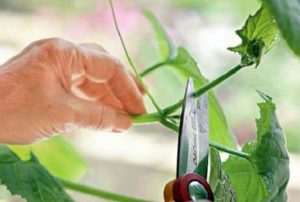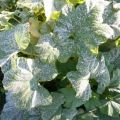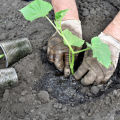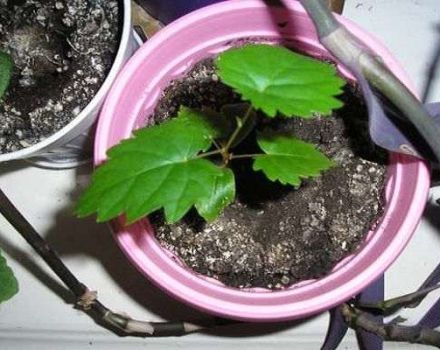At what distance do you need to plant cucumbers with seedlings and seeds in the open field
Every gardener wants the yield in his beds to be maximum, and he could boast of this to friends. This also applies to cucumbers. What kind of summer cottage can do without this culture? To get a good harvest of cucumbers, you need to clearly follow some rules. These rules include choosing the right variety, and the time of planting seedlings, feeding rules and knowing at what distance to plant cucumbers. All of this is extremely important in order for the cucumbers to receive the maximum possible nutrients.
General information
Cucumbers have long been known to people and are revered for their beneficial qualities and properties. They make twists for the winter period, are widely used for cosmetic purposes, make extracts from them, and cucumbers are also of great importance in dietology.
Each summer resident tries to maximize the yield of these useful and irreplaceable vegetables, and grows this garden crop both in a greenhouse and in the open field. But just planting cucumbers is not enough.
You need to know at what distance to plant cucumbers in open ground. If you do not adhere to these simple rules, the plant will produce significantly worse fruit, ache and degenerate.
Drop off distance
First, let's figure out at what distance to plant cucumbers in open ground? You can cultivate cucumbers in a greenhouse using 2 methods:
- horizontal;
- vertical.

But, despite this, there is a general scheme, subject to which you can get the maximum yield. The key is how far apart to plant and how to plant cucumbers. The total distance between cucumbers during planting should be at least 20 cm, and between the beds themselves at least 45 cm.You can plant in 2 rows, and make a passage between them at least 95 cm.This scheme has proven itself well with the method vertical planting of cucumbers.
For horizontal planting, cucumber bushes must be tied to specially designed pallets. You can use sturdy twine or stretch the wire.
Seeds or seedlings sprouted in advance must be planted, adhering to a special checkerboard order. With this method of planting cucumbers, the distance between the bushes in the same row should be at least 65 cm.
Germination and cultivation of cucumber culture
Every connoisseur who at least once came across the culture of cucumbers knows that there are 2 ways of growing - by seedlings or by seeds.But not all gardening enthusiasts are aware that the best yield from a bush is obtained only if the plant is correctly planted beforehand and all the rules are followed. It is also extremely important to choose seeds for germination that are stratified, resistant, and have high yields.
Note! In order to get the maximum yield from your garden or greenhouse with cucumbers, it is not enough just to adhere to the planting scheme. An important criterion is a properly prepared soil for planting. If the soil contains a small supply of essential minerals and other useful elements, the harvest may not wait. If the soil is oversaturated with useful components, the planting distance can be significantly reduced.
This will be relevant if the land allocated for the garden is small, and you need not only to plant cucumbers, but also other types of vegetables and berries.
The horizontal method of planting cucumbers is very suitable for planting plants in open soil, where there is enough free space. Cucumber bushes tend to grow randomly on the soil surface.
In a greenhouse, such a planting is inconvenient. But experts do not recommend watering with horizontal planting in the usual way. The fact is that the soil begins to compact, forming a surface crust. This greatly complicates the further growth and development of cucumbers.
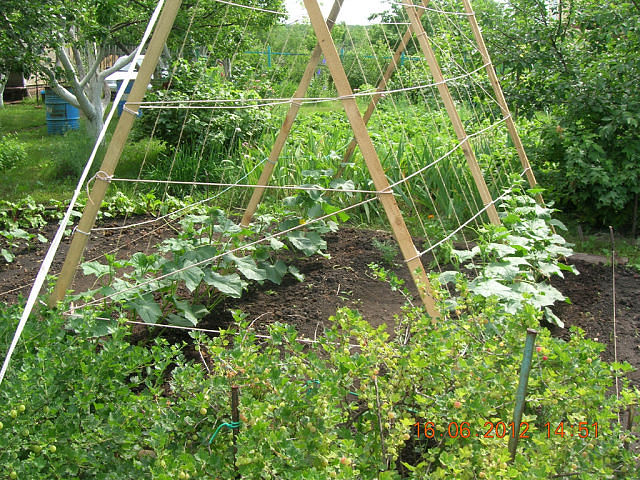
Preparation of soil for planting cucumbers in greenhouse conditions
It has already been indicated above that prepared cucumbers can only be planted in the soil, which is rich in a large amount of mineral and nutrients. For this, you can use ready-made mixtures. But from a financial point of view, this is not economical at all.
Not everything is so scary, you can easily prepare the mixture yourself. In this case, you can use natural ingredients, such as compost, humus or ash.
In connection with the development of technology, on the shelves of horticultural and horticultural stores, you can find a large number of goods to help farmers. Active bacteria are one such know-how. They will help enrich the soil of your garden plot. These bacteria are created to eliminate bad odors from outdoor toilets and cesspools.
Bacteria are able to process any kind of sewage, converting them into the category of industrial water. These microorganisms are diluted in water, poured into a cesspool or toilet. The water that is obtained after such processing is cleared of possible suspensions of chlorine, detergents and other things. Such a liquid can be safely used for watering a vegetable garden and cucumbers in the open field. Microorganisms continue to actively grow and develop, and then begin to settle to the bottom. This type of silt can be safely used for composting.
The type of fertilizer obtained in this way can be used to enrich the soil in greenhouses, greenhouses, or in open soil. You can use cattle manure and ash.
Planting cucumbers in a "warm bed"
Experienced summer residents and farmers assure that the best way to grow cucumbers is a “warm bed”. An important criterion for plant growth is considered to be heat, localized in the place of the root system. This will make the harvest much larger. Such a bed does not require special costs for its creation. You can use all the plant debris on the site and plant cucumber seedlings right there. Such garbage can be:
- straw;
- mown herbs before flowering;
- leaves from trees;
- small sawdust;
- coniferous twigs;
- unnecessary paper.
Do not use potato, tomato, vegetable marrow or pumpkin tops as garbage to create a “warm bed”.

In early spring, you need to choose a place for the future garden. It is necessary that it be light enough, under the sun, while being protected from the winds. Vegetable debris is mixed, placing it on level ground. The width of the bed should be 75-85 cm, the length can be at the discretion of the gardener. The “warm bed” should be high enough - 55-65 cm.
Vegetable debris is placed, watered with warm water, then they begin to ram. You can just walk along this bed with your feet for subsequent shrinkage. Then you can start sowing seeds.
Schematic planting
Scheme for planting cucumbers in open ground implies by itself the choice of the territory where future cucumbers will have to grow. You can use the area where tomatoes and root crops were previously grown.
It is worth remembering that cucumbers that are planted in greenhouse conditions must receive the proper amount of sunlight and, accordingly, heat. The temperature in this room should not be lower than 21 degrees.
Using the equipment intended for planting, it is necessary to make markings for future beds. Mark holes in the same place. What distance should be between them? The gap between the cucumber bushes depends on the variety of the future plant. There are species that simply need space, and they cannot withstand the proximity of other plants.
During planting, and especially for seedlings, supports must be installed on the garden bed. To do this, use pins made of metal, wood. A string or wire is pulled between these supports. It is important to correctly place the cucumbers on the support, as they are climbing plants. Then they will begin to trudge on their own. With a certain desire, gardeners can form beautiful, pleasant from the point of view of aesthetics, bushes.
The planting material is planted in wells prepared in advance, which can be done much faster, but we must not forget about the planting scheme. When planted in a checkerboard pattern, the plant will get more space in the future, which will have a positive effect on the future harvest.
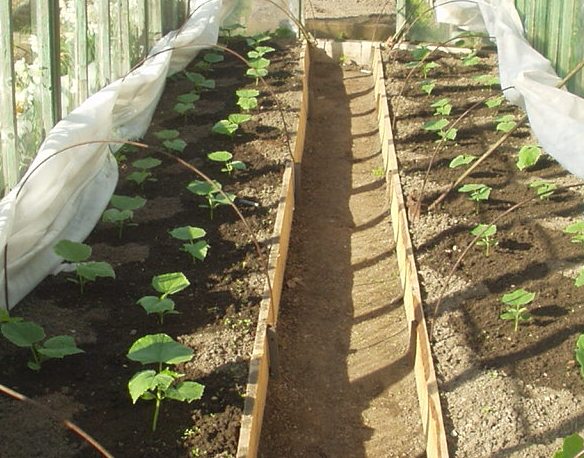
When replanting plants from pots, you need to make sure that part of the earthen coma remains above the surface of the garden. The fact is that the root neck should not touch the ground, otherwise infection with all kinds of diseases is possible.
Cucumbers are not very whimsical, nevertheless, they require close attention to themselves.
Fertilizing cucumbers planted in a greenhouse
If the preparation of the soil for planting cucumbers was done according to all the rules, then additional fertilizing may not be needed. But every gardener and gardener tries to do everything right as much as possible to achieve the best results.
Important! Cucumbers that are grown in greenhouses require much more attention than those planted in open ground with seeds.
By feeding plants correctly and on time, you can most likely grow disease-resistant cucumbers.
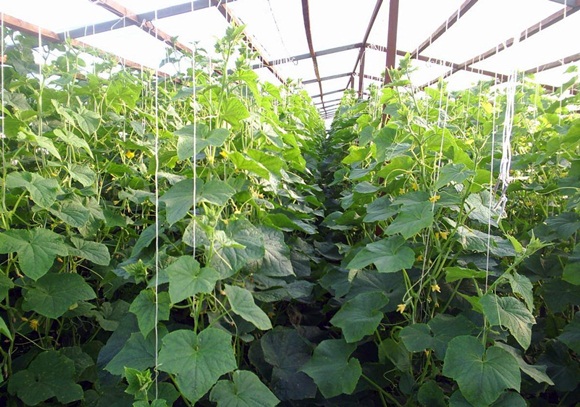
- If you pre-germinate seeds before planting them in the soil, then you can add a small amount of natural honey to the water. It will act as a strong and powerful catalyst for the seed germination process. The first shoots will begin to appear much faster.
- Top dressing can be given when the first true leaf sprouts. As a rule, organics containing K, P and nitrogen are used. These components are indispensable for the future cucumber. The lack of these elements can affect the general condition of the plant, as well as cause various diseases and even its death.
- At the beginning of the flowering period, it is necessary to fertilize the soil with products high in magnesium and potassium.The same fertilizers can be used during the fruiting period of seedlings.
You can use fertilizers that are at hand when planting cucumbers - yeast and ash. A glass of ash is diluted in water, allowed to brew, and then they begin to water the plants. Yeast is diluted in warm water with added sugar. They are kept in a warm place until the foam disappears on the surface of the liquid, this takes about 4 days. The product obtained during fermentation is diluted in five liters of water and poured over the plants.
In order to fight various diseases, Bordeaux mixture is widely used. This complex of copper sulfate and slaked lime can help to preserve not only the yield of cucumbers, but also protect other plant species in the garden from diseases.

